Tata Steel: Comprehensive Business and Risk Analysis Report
VerifiedAdded on 2022/02/21
|17
|3651
|36
Report
AI Summary
This report offers a comprehensive analysis of Tata Steel, a leading steel company founded in India. It begins with an overview of the company, its business segments (including construction, automotive, and general engineering), and its strategic positioning using a TOWS matrix. The report then examines Tata Steel's customer base, competitors (including SAIL and JSW Steel), and collaborators. A significant portion is dedicated to a country risk analysis, assessing political, economic, social, technological, legal, and environmental factors, along with specific risks like expropriation, labor legislation, and the impact of the COVID-19 pandemic. The report also delves into the cultural web, managerial implications, and ethical considerations. Finally, it explores entry strategies and concludes with references.
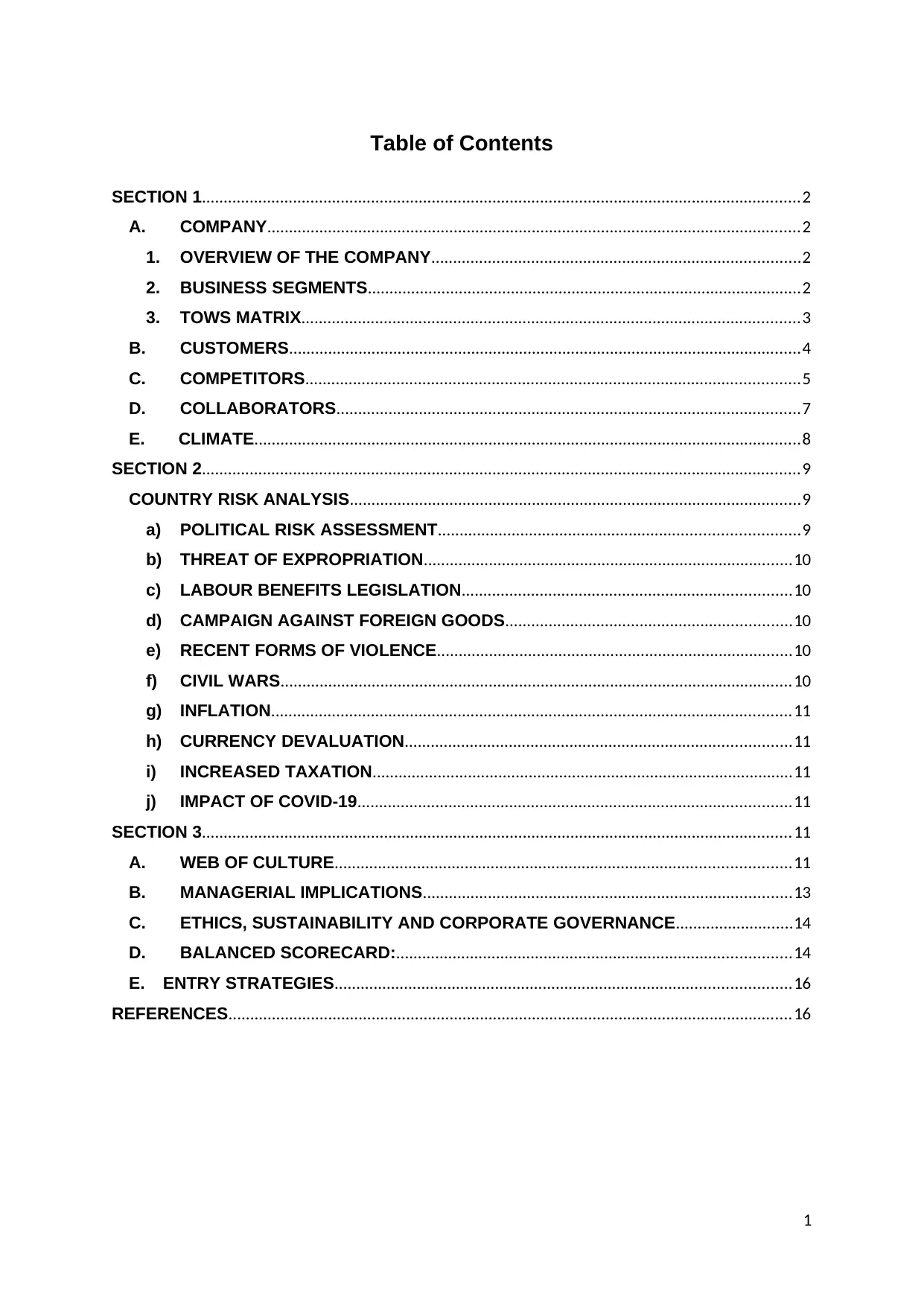
Table of Contents
SECTION 1..........................................................................................................................................2
A. COMPANY...........................................................................................................................2
1. OVERVIEW OF THE COMPANY.....................................................................................2
2. BUSINESS SEGMENTS....................................................................................................2
3. TOWS MATRIX...................................................................................................................3
B. CUSTOMERS......................................................................................................................4
C. COMPETITORS..................................................................................................................5
D. COLLABORATORS...........................................................................................................7
E. CLIMATE..............................................................................................................................8
SECTION 2..........................................................................................................................................9
COUNTRY RISK ANALYSIS........................................................................................................9
a) POLITICAL RISK ASSESSMENT...................................................................................9
b) THREAT OF EXPROPRIATION.....................................................................................10
c) LABOUR BENEFITS LEGISLATION............................................................................10
d) CAMPAIGN AGAINST FOREIGN GOODS..................................................................10
e) RECENT FORMS OF VIOLENCE..................................................................................10
f) CIVIL WARS......................................................................................................................10
g) INFLATION........................................................................................................................11
h) CURRENCY DEVALUATION.........................................................................................11
i) INCREASED TAXATION.................................................................................................11
j) IMPACT OF COVID-19....................................................................................................11
SECTION 3........................................................................................................................................11
A. WEB OF CULTURE.........................................................................................................11
B. MANAGERIAL IMPLICATIONS.....................................................................................13
C. ETHICS, SUSTAINABILITY AND CORPORATE GOVERNANCE...........................14
D. BALANCED SCORECARD:...........................................................................................14
E. ENTRY STRATEGIES.........................................................................................................16
REFERENCES..................................................................................................................................16
1
SECTION 1..........................................................................................................................................2
A. COMPANY...........................................................................................................................2
1. OVERVIEW OF THE COMPANY.....................................................................................2
2. BUSINESS SEGMENTS....................................................................................................2
3. TOWS MATRIX...................................................................................................................3
B. CUSTOMERS......................................................................................................................4
C. COMPETITORS..................................................................................................................5
D. COLLABORATORS...........................................................................................................7
E. CLIMATE..............................................................................................................................8
SECTION 2..........................................................................................................................................9
COUNTRY RISK ANALYSIS........................................................................................................9
a) POLITICAL RISK ASSESSMENT...................................................................................9
b) THREAT OF EXPROPRIATION.....................................................................................10
c) LABOUR BENEFITS LEGISLATION............................................................................10
d) CAMPAIGN AGAINST FOREIGN GOODS..................................................................10
e) RECENT FORMS OF VIOLENCE..................................................................................10
f) CIVIL WARS......................................................................................................................10
g) INFLATION........................................................................................................................11
h) CURRENCY DEVALUATION.........................................................................................11
i) INCREASED TAXATION.................................................................................................11
j) IMPACT OF COVID-19....................................................................................................11
SECTION 3........................................................................................................................................11
A. WEB OF CULTURE.........................................................................................................11
B. MANAGERIAL IMPLICATIONS.....................................................................................13
C. ETHICS, SUSTAINABILITY AND CORPORATE GOVERNANCE...........................14
D. BALANCED SCORECARD:...........................................................................................14
E. ENTRY STRATEGIES.........................................................................................................16
REFERENCES..................................................................................................................................16
1
Paraphrase This Document
Need a fresh take? Get an instant paraphrase of this document with our AI Paraphraser
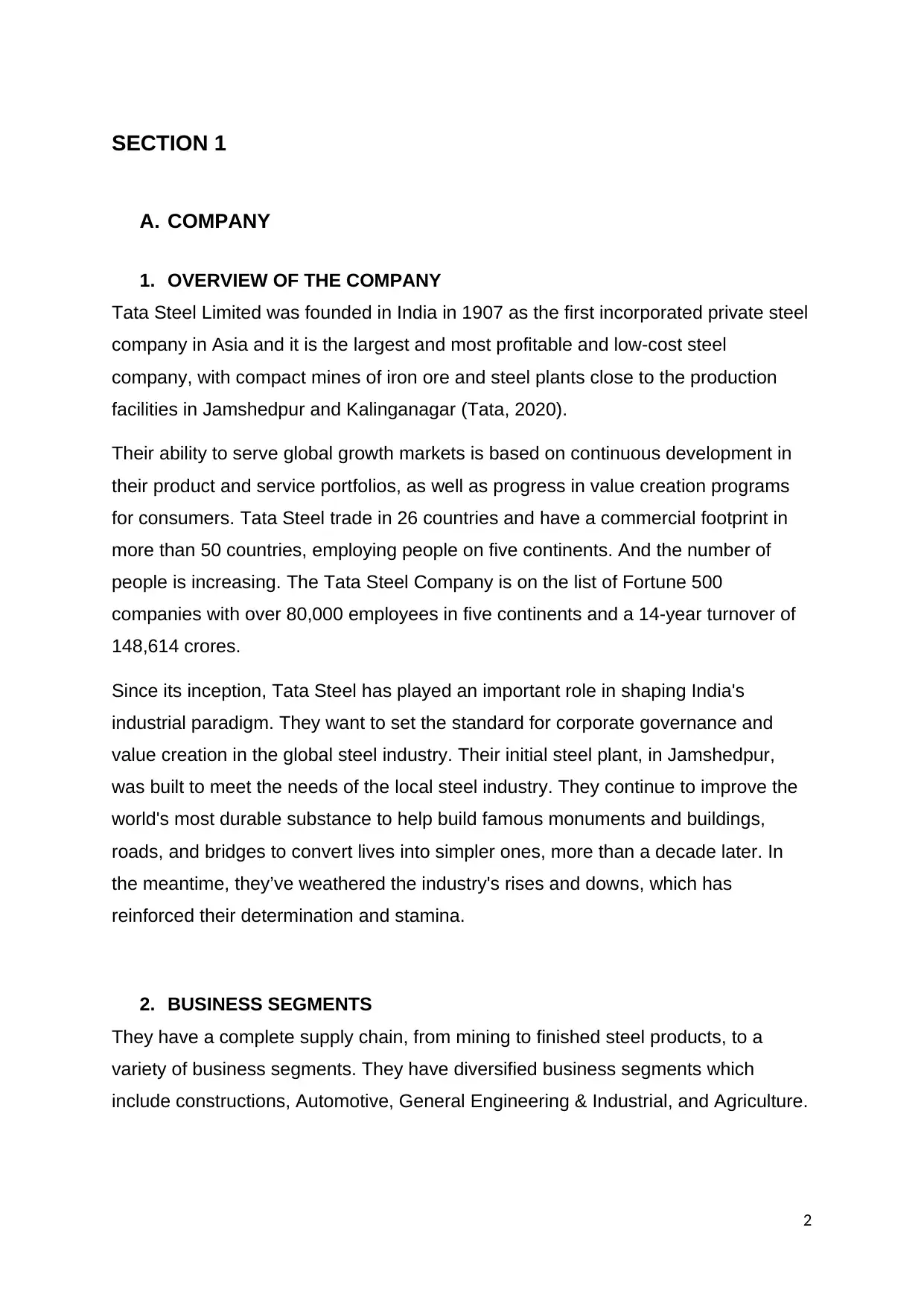
SECTION 1
A. COMPANY
1. OVERVIEW OF THE COMPANY
Tata Steel Limited was founded in India in 1907 as the first incorporated private steel
company in Asia and it is the largest and most profitable and low-cost steel
company, with compact mines of iron ore and steel plants close to the production
facilities in Jamshedpur and Kalinganagar (Tata, 2020).
Their ability to serve global growth markets is based on continuous development in
their product and service portfolios, as well as progress in value creation programs
for consumers. Tata Steel trade in 26 countries and have a commercial footprint in
more than 50 countries, employing people on five continents. And the number of
people is increasing. The Tata Steel Company is on the list of Fortune 500
companies with over 80,000 employees in five continents and a 14-year turnover of
148,614 crores.
Since its inception, Tata Steel has played an important role in shaping India's
industrial paradigm. They want to set the standard for corporate governance and
value creation in the global steel industry. Their initial steel plant, in Jamshedpur,
was built to meet the needs of the local steel industry. They continue to improve the
world's most durable substance to help build famous monuments and buildings,
roads, and bridges to convert lives into simpler ones, more than a decade later. In
the meantime, they’ve weathered the industry's rises and downs, which has
reinforced their determination and stamina.
2. BUSINESS SEGMENTS
They have a complete supply chain, from mining to finished steel products, to a
variety of business segments. They have diversified business segments which
include constructions, Automotive, General Engineering & Industrial, and Agriculture.
2
A. COMPANY
1. OVERVIEW OF THE COMPANY
Tata Steel Limited was founded in India in 1907 as the first incorporated private steel
company in Asia and it is the largest and most profitable and low-cost steel
company, with compact mines of iron ore and steel plants close to the production
facilities in Jamshedpur and Kalinganagar (Tata, 2020).
Their ability to serve global growth markets is based on continuous development in
their product and service portfolios, as well as progress in value creation programs
for consumers. Tata Steel trade in 26 countries and have a commercial footprint in
more than 50 countries, employing people on five continents. And the number of
people is increasing. The Tata Steel Company is on the list of Fortune 500
companies with over 80,000 employees in five continents and a 14-year turnover of
148,614 crores.
Since its inception, Tata Steel has played an important role in shaping India's
industrial paradigm. They want to set the standard for corporate governance and
value creation in the global steel industry. Their initial steel plant, in Jamshedpur,
was built to meet the needs of the local steel industry. They continue to improve the
world's most durable substance to help build famous monuments and buildings,
roads, and bridges to convert lives into simpler ones, more than a decade later. In
the meantime, they’ve weathered the industry's rises and downs, which has
reinforced their determination and stamina.
2. BUSINESS SEGMENTS
They have a complete supply chain, from mining to finished steel products, to a
variety of business segments. They have diversified business segments which
include constructions, Automotive, General Engineering & Industrial, and Agriculture.
2
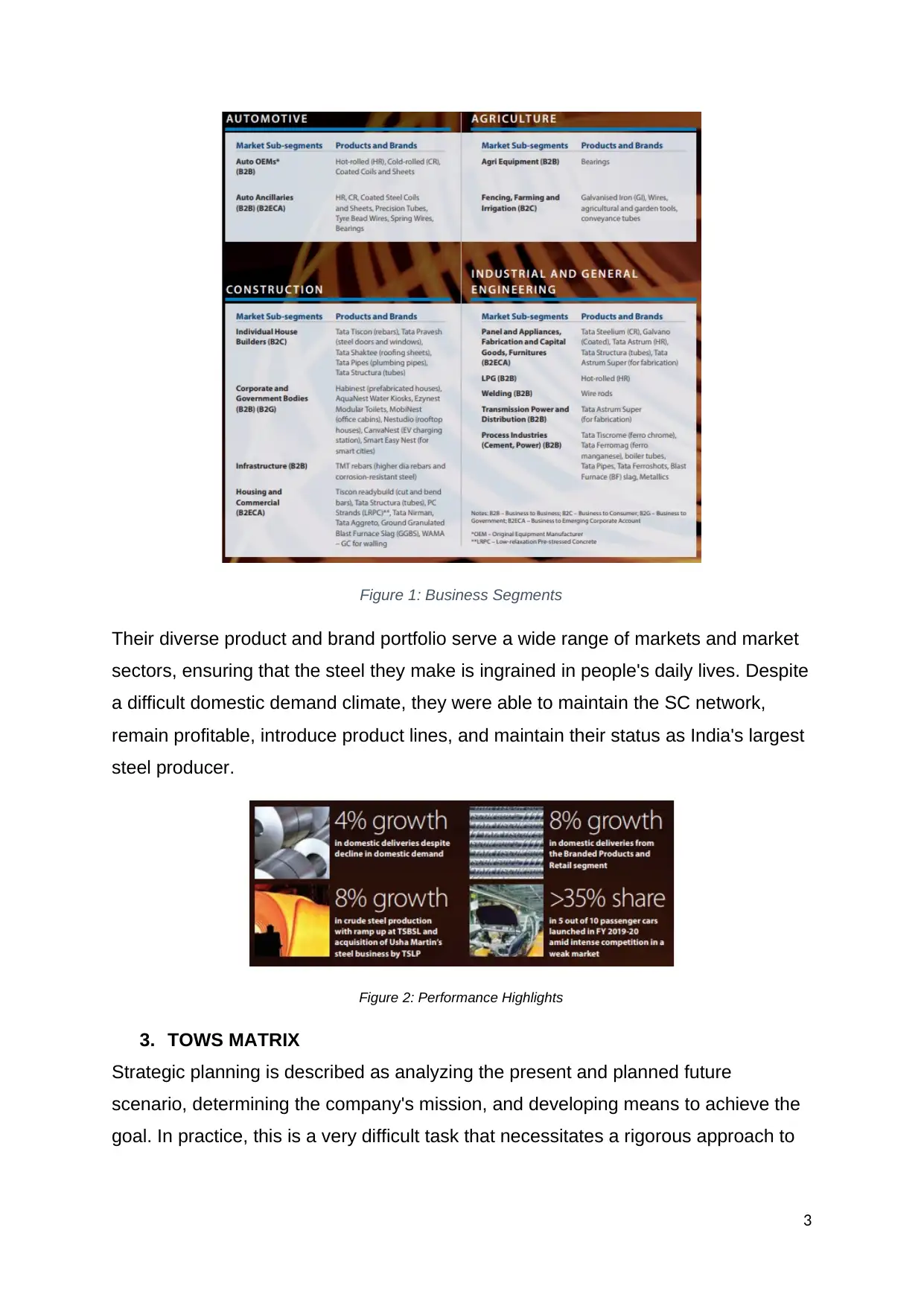
Figure 1: Business Segments
Their diverse product and brand portfolio serve a wide range of markets and market
sectors, ensuring that the steel they make is ingrained in people's daily lives. Despite
a difficult domestic demand climate, they were able to maintain the SC network,
remain profitable, introduce product lines, and maintain their status as India's largest
steel producer.
Figure 2: Performance Highlights
3. TOWS MATRIX
Strategic planning is described as analyzing the present and planned future
scenario, determining the company's mission, and developing means to achieve the
goal. In practice, this is a very difficult task that necessitates a rigorous approach to
3
Their diverse product and brand portfolio serve a wide range of markets and market
sectors, ensuring that the steel they make is ingrained in people's daily lives. Despite
a difficult domestic demand climate, they were able to maintain the SC network,
remain profitable, introduce product lines, and maintain their status as India's largest
steel producer.
Figure 2: Performance Highlights
3. TOWS MATRIX
Strategic planning is described as analyzing the present and planned future
scenario, determining the company's mission, and developing means to achieve the
goal. In practice, this is a very difficult task that necessitates a rigorous approach to
3
⊘ This is a preview!⊘
Do you want full access?
Subscribe today to unlock all pages.

Trusted by 1+ million students worldwide
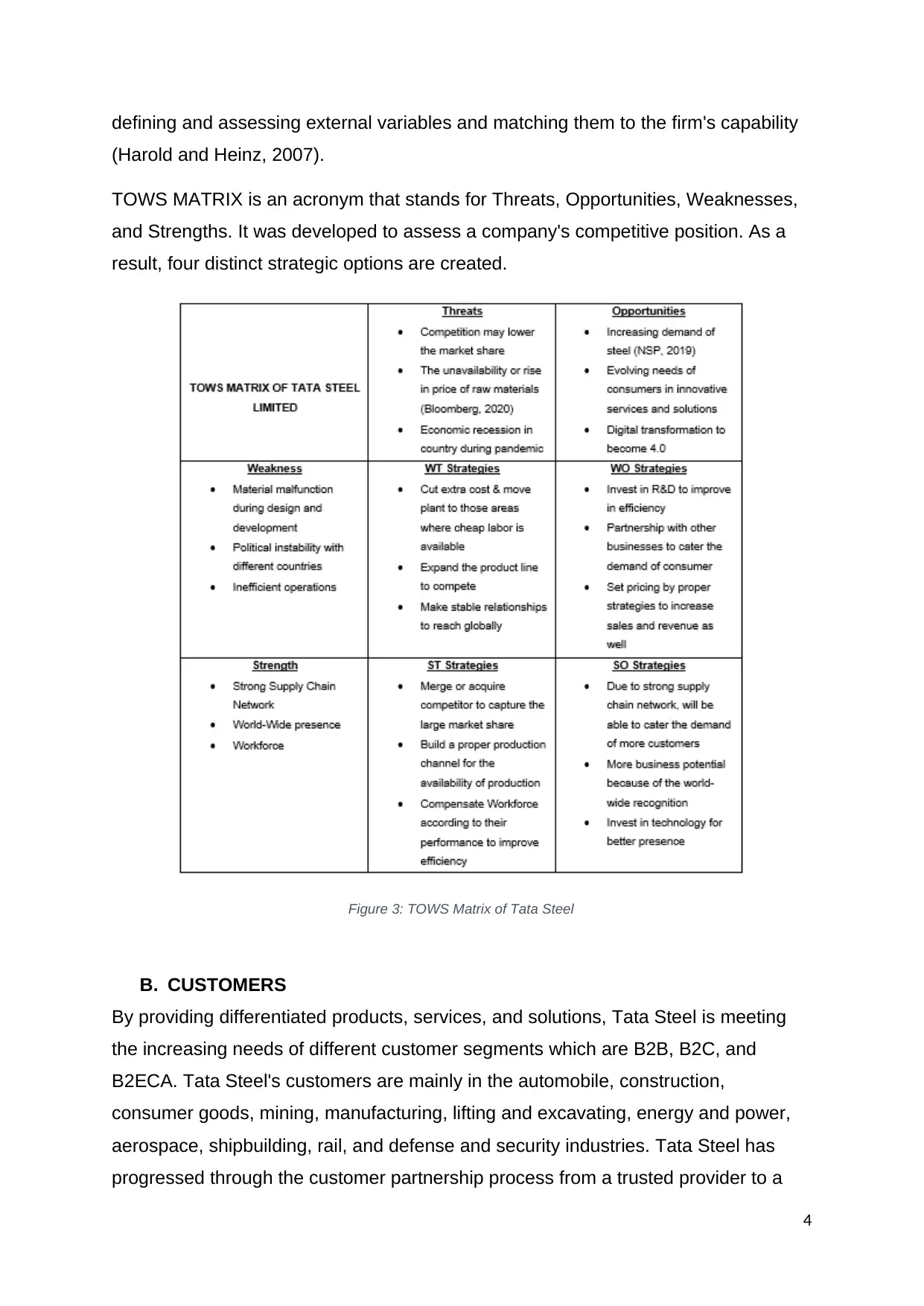
defining and assessing external variables and matching them to the firm's capability
(Harold and Heinz, 2007).
TOWS MATRIX is an acronym that stands for Threats, Opportunities, Weaknesses,
and Strengths. It was developed to assess a company's competitive position. As a
result, four distinct strategic options are created.
Figure 3: TOWS Matrix of Tata Steel
B. CUSTOMERS
By providing differentiated products, services, and solutions, Tata Steel is meeting
the increasing needs of different customer segments which are B2B, B2C, and
B2ECA. Tata Steel's customers are mainly in the automobile, construction,
consumer goods, mining, manufacturing, lifting and excavating, energy and power,
aerospace, shipbuilding, rail, and defense and security industries. Tata Steel has
progressed through the customer partnership process from a trusted provider to a
4
(Harold and Heinz, 2007).
TOWS MATRIX is an acronym that stands for Threats, Opportunities, Weaknesses,
and Strengths. It was developed to assess a company's competitive position. As a
result, four distinct strategic options are created.
Figure 3: TOWS Matrix of Tata Steel
B. CUSTOMERS
By providing differentiated products, services, and solutions, Tata Steel is meeting
the increasing needs of different customer segments which are B2B, B2C, and
B2ECA. Tata Steel's customers are mainly in the automobile, construction,
consumer goods, mining, manufacturing, lifting and excavating, energy and power,
aerospace, shipbuilding, rail, and defense and security industries. Tata Steel has
progressed through the customer partnership process from a trusted provider to a
4
Paraphrase This Document
Need a fresh take? Get an instant paraphrase of this document with our AI Paraphraser
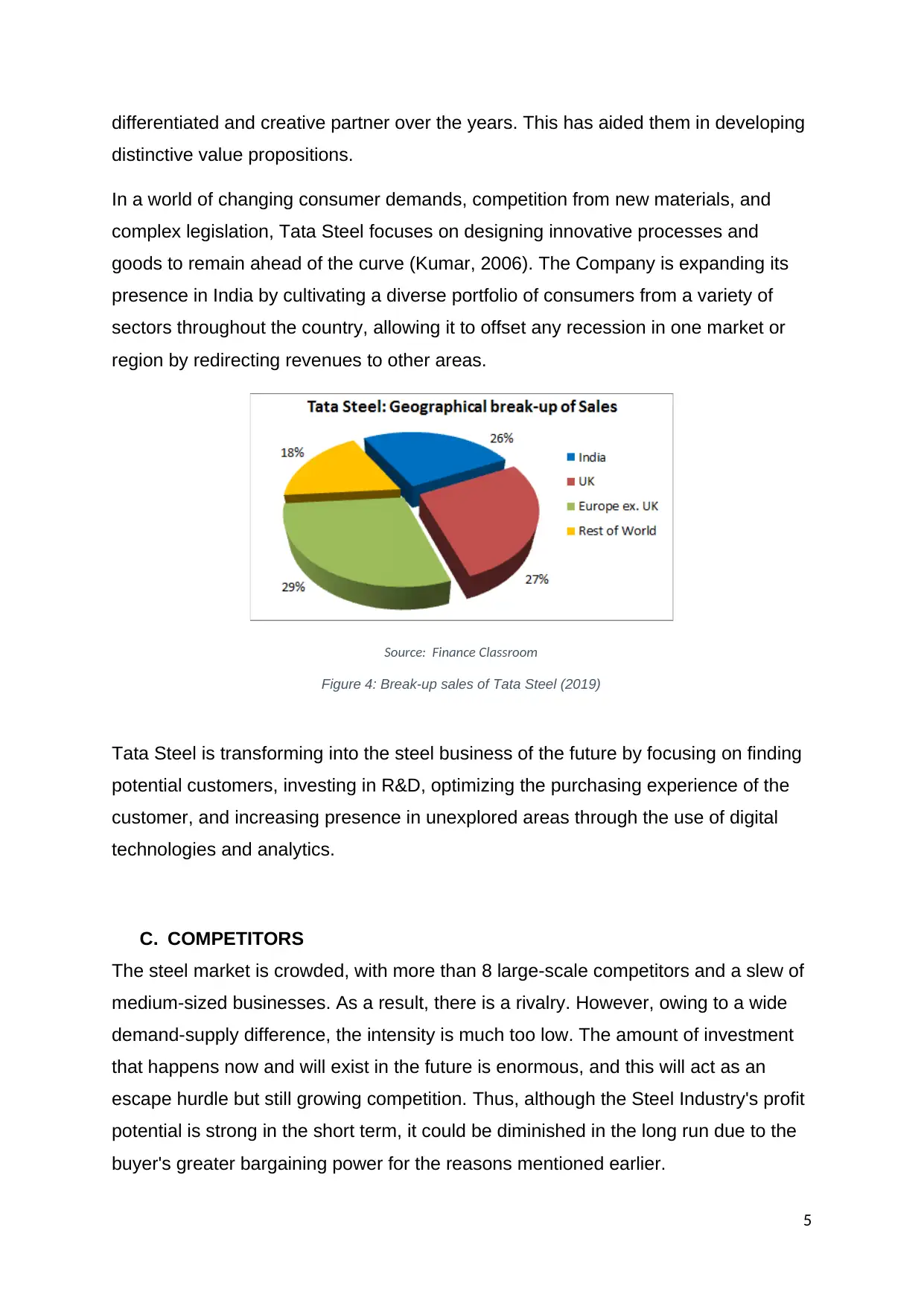
differentiated and creative partner over the years. This has aided them in developing
distinctive value propositions.
In a world of changing consumer demands, competition from new materials, and
complex legislation, Tata Steel focuses on designing innovative processes and
goods to remain ahead of the curve (Kumar, 2006). The Company is expanding its
presence in India by cultivating a diverse portfolio of consumers from a variety of
sectors throughout the country, allowing it to offset any recession in one market or
region by redirecting revenues to other areas.
Source: Finance Classroom
Figure 4: Break-up sales of Tata Steel (2019)
Tata Steel is transforming into the steel business of the future by focusing on finding
potential customers, investing in R&D, optimizing the purchasing experience of the
customer, and increasing presence in unexplored areas through the use of digital
technologies and analytics.
C. COMPETITORS
The steel market is crowded, with more than 8 large-scale competitors and a slew of
medium-sized businesses. As a result, there is a rivalry. However, owing to a wide
demand-supply difference, the intensity is much too low. The amount of investment
that happens now and will exist in the future is enormous, and this will act as an
escape hurdle but still growing competition. Thus, although the Steel Industry's profit
potential is strong in the short term, it could be diminished in the long run due to the
buyer's greater bargaining power for the reasons mentioned earlier.
5
distinctive value propositions.
In a world of changing consumer demands, competition from new materials, and
complex legislation, Tata Steel focuses on designing innovative processes and
goods to remain ahead of the curve (Kumar, 2006). The Company is expanding its
presence in India by cultivating a diverse portfolio of consumers from a variety of
sectors throughout the country, allowing it to offset any recession in one market or
region by redirecting revenues to other areas.
Source: Finance Classroom
Figure 4: Break-up sales of Tata Steel (2019)
Tata Steel is transforming into the steel business of the future by focusing on finding
potential customers, investing in R&D, optimizing the purchasing experience of the
customer, and increasing presence in unexplored areas through the use of digital
technologies and analytics.
C. COMPETITORS
The steel market is crowded, with more than 8 large-scale competitors and a slew of
medium-sized businesses. As a result, there is a rivalry. However, owing to a wide
demand-supply difference, the intensity is much too low. The amount of investment
that happens now and will exist in the future is enormous, and this will act as an
escape hurdle but still growing competition. Thus, although the Steel Industry's profit
potential is strong in the short term, it could be diminished in the long run due to the
buyer's greater bargaining power for the reasons mentioned earlier.
5
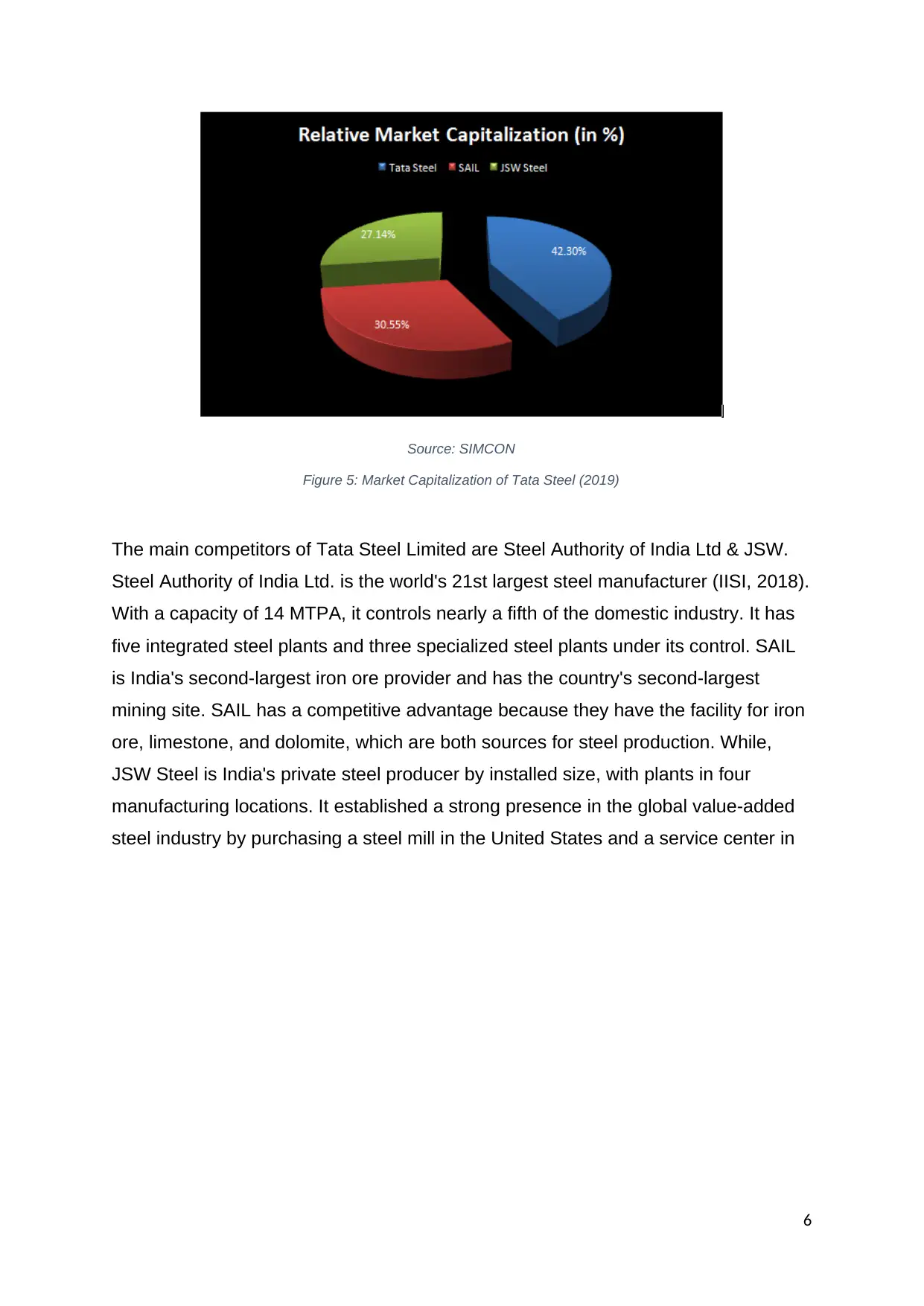
Source: SIMCON
Figure 5: Market Capitalization of Tata Steel (2019)
The main competitors of Tata Steel Limited are Steel Authority of India Ltd & JSW.
Steel Authority of India Ltd. is the world's 21st largest steel manufacturer (IISI, 2018).
With a capacity of 14 MTPA, it controls nearly a fifth of the domestic industry. It has
five integrated steel plants and three specialized steel plants under its control. SAIL
is India's second-largest iron ore provider and has the country's second-largest
mining site. SAIL has a competitive advantage because they have the facility for iron
ore, limestone, and dolomite, which are both sources for steel production. While,
JSW Steel is India's private steel producer by installed size, with plants in four
manufacturing locations. It established a strong presence in the global value-added
steel industry by purchasing a steel mill in the United States and a service center in
6
Figure 5: Market Capitalization of Tata Steel (2019)
The main competitors of Tata Steel Limited are Steel Authority of India Ltd & JSW.
Steel Authority of India Ltd. is the world's 21st largest steel manufacturer (IISI, 2018).
With a capacity of 14 MTPA, it controls nearly a fifth of the domestic industry. It has
five integrated steel plants and three specialized steel plants under its control. SAIL
is India's second-largest iron ore provider and has the country's second-largest
mining site. SAIL has a competitive advantage because they have the facility for iron
ore, limestone, and dolomite, which are both sources for steel production. While,
JSW Steel is India's private steel producer by installed size, with plants in four
manufacturing locations. It established a strong presence in the global value-added
steel industry by purchasing a steel mill in the United States and a service center in
6
⊘ This is a preview!⊘
Do you want full access?
Subscribe today to unlock all pages.

Trusted by 1+ million students worldwide
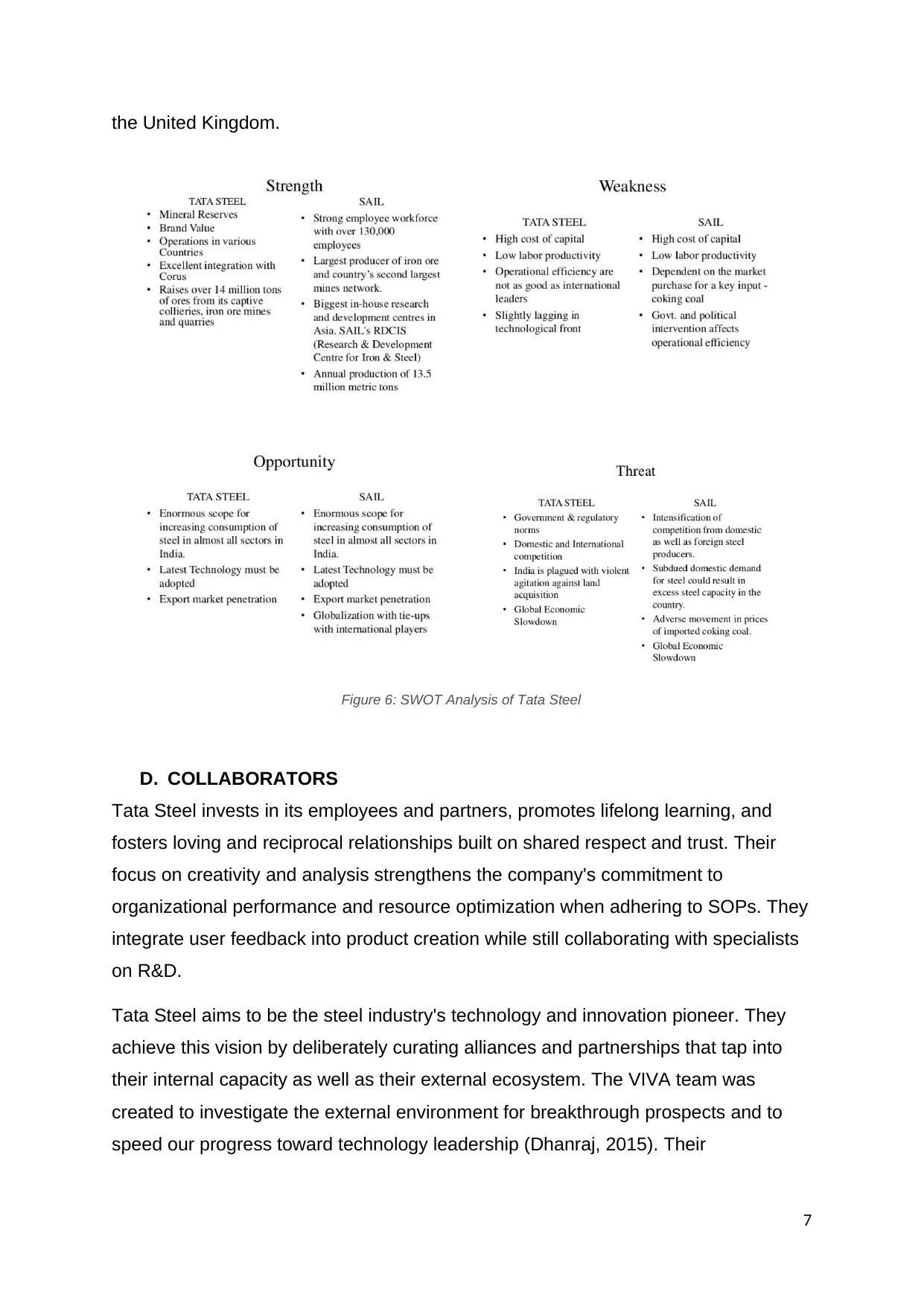
the United Kingdom.
Figure 6: SWOT Analysis of Tata Steel
D. COLLABORATORS
Tata Steel invests in its employees and partners, promotes lifelong learning, and
fosters loving and reciprocal relationships built on shared respect and trust. Their
focus on creativity and analysis strengthens the company's commitment to
organizational performance and resource optimization when adhering to SOPs. They
integrate user feedback into product creation while still collaborating with specialists
on R&D.
Tata Steel aims to be the steel industry's technology and innovation pioneer. They
achieve this vision by deliberately curating alliances and partnerships that tap into
their internal capacity as well as their external ecosystem. The VIVA team was
created to investigate the external environment for breakthrough prospects and to
speed our progress toward technology leadership (Dhanraj, 2015). Their
7
Figure 6: SWOT Analysis of Tata Steel
D. COLLABORATORS
Tata Steel invests in its employees and partners, promotes lifelong learning, and
fosters loving and reciprocal relationships built on shared respect and trust. Their
focus on creativity and analysis strengthens the company's commitment to
organizational performance and resource optimization when adhering to SOPs. They
integrate user feedback into product creation while still collaborating with specialists
on R&D.
Tata Steel aims to be the steel industry's technology and innovation pioneer. They
achieve this vision by deliberately curating alliances and partnerships that tap into
their internal capacity as well as their external ecosystem. The VIVA team was
created to investigate the external environment for breakthrough prospects and to
speed our progress toward technology leadership (Dhanraj, 2015). Their
7
Paraphrase This Document
Need a fresh take? Get an instant paraphrase of this document with our AI Paraphraser
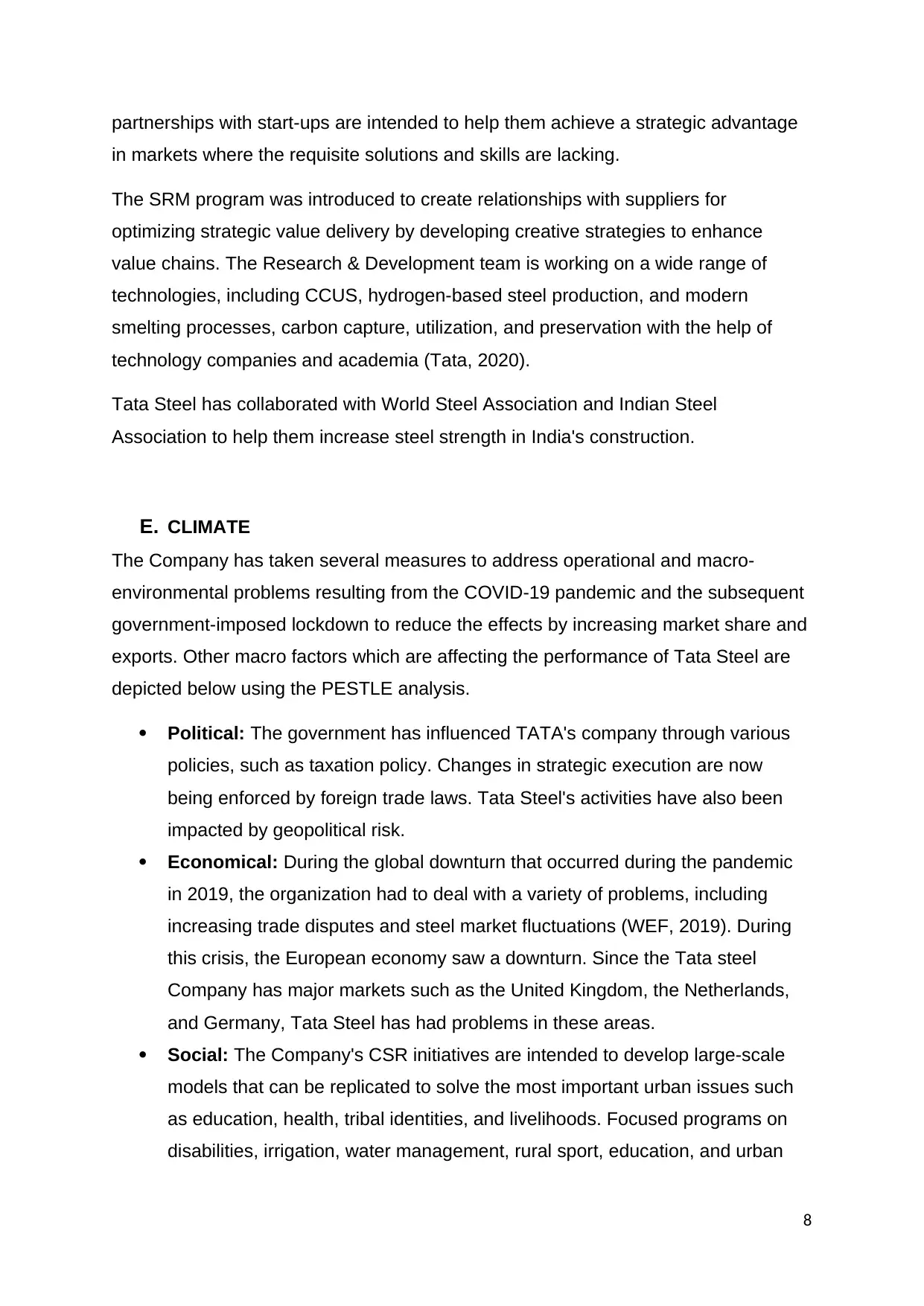
partnerships with start-ups are intended to help them achieve a strategic advantage
in markets where the requisite solutions and skills are lacking.
The SRM program was introduced to create relationships with suppliers for
optimizing strategic value delivery by developing creative strategies to enhance
value chains. The Research & Development team is working on a wide range of
technologies, including CCUS, hydrogen-based steel production, and modern
smelting processes, carbon capture, utilization, and preservation with the help of
technology companies and academia (Tata, 2020).
Tata Steel has collaborated with World Steel Association and Indian Steel
Association to help them increase steel strength in India's construction.
E. CLIMATE
The Company has taken several measures to address operational and macro-
environmental problems resulting from the COVID-19 pandemic and the subsequent
government-imposed lockdown to reduce the effects by increasing market share and
exports. Other macro factors which are affecting the performance of Tata Steel are
depicted below using the PESTLE analysis.
Political: The government has influenced TATA's company through various
policies, such as taxation policy. Changes in strategic execution are now
being enforced by foreign trade laws. Tata Steel's activities have also been
impacted by geopolitical risk.
Economical: During the global downturn that occurred during the pandemic
in 2019, the organization had to deal with a variety of problems, including
increasing trade disputes and steel market fluctuations (WEF, 2019). During
this crisis, the European economy saw a downturn. Since the Tata steel
Company has major markets such as the United Kingdom, the Netherlands,
and Germany, Tata Steel has had problems in these areas.
Social: The Company's CSR initiatives are intended to develop large-scale
models that can be replicated to solve the most important urban issues such
as education, health, tribal identities, and livelihoods. Focused programs on
disabilities, irrigation, water management, rural sport, education, and urban
8
in markets where the requisite solutions and skills are lacking.
The SRM program was introduced to create relationships with suppliers for
optimizing strategic value delivery by developing creative strategies to enhance
value chains. The Research & Development team is working on a wide range of
technologies, including CCUS, hydrogen-based steel production, and modern
smelting processes, carbon capture, utilization, and preservation with the help of
technology companies and academia (Tata, 2020).
Tata Steel has collaborated with World Steel Association and Indian Steel
Association to help them increase steel strength in India's construction.
E. CLIMATE
The Company has taken several measures to address operational and macro-
environmental problems resulting from the COVID-19 pandemic and the subsequent
government-imposed lockdown to reduce the effects by increasing market share and
exports. Other macro factors which are affecting the performance of Tata Steel are
depicted below using the PESTLE analysis.
Political: The government has influenced TATA's company through various
policies, such as taxation policy. Changes in strategic execution are now
being enforced by foreign trade laws. Tata Steel's activities have also been
impacted by geopolitical risk.
Economical: During the global downturn that occurred during the pandemic
in 2019, the organization had to deal with a variety of problems, including
increasing trade disputes and steel market fluctuations (WEF, 2019). During
this crisis, the European economy saw a downturn. Since the Tata steel
Company has major markets such as the United Kingdom, the Netherlands,
and Germany, Tata Steel has had problems in these areas.
Social: The Company's CSR initiatives are intended to develop large-scale
models that can be replicated to solve the most important urban issues such
as education, health, tribal identities, and livelihoods. Focused programs on
disabilities, irrigation, water management, rural sport, education, and urban
8
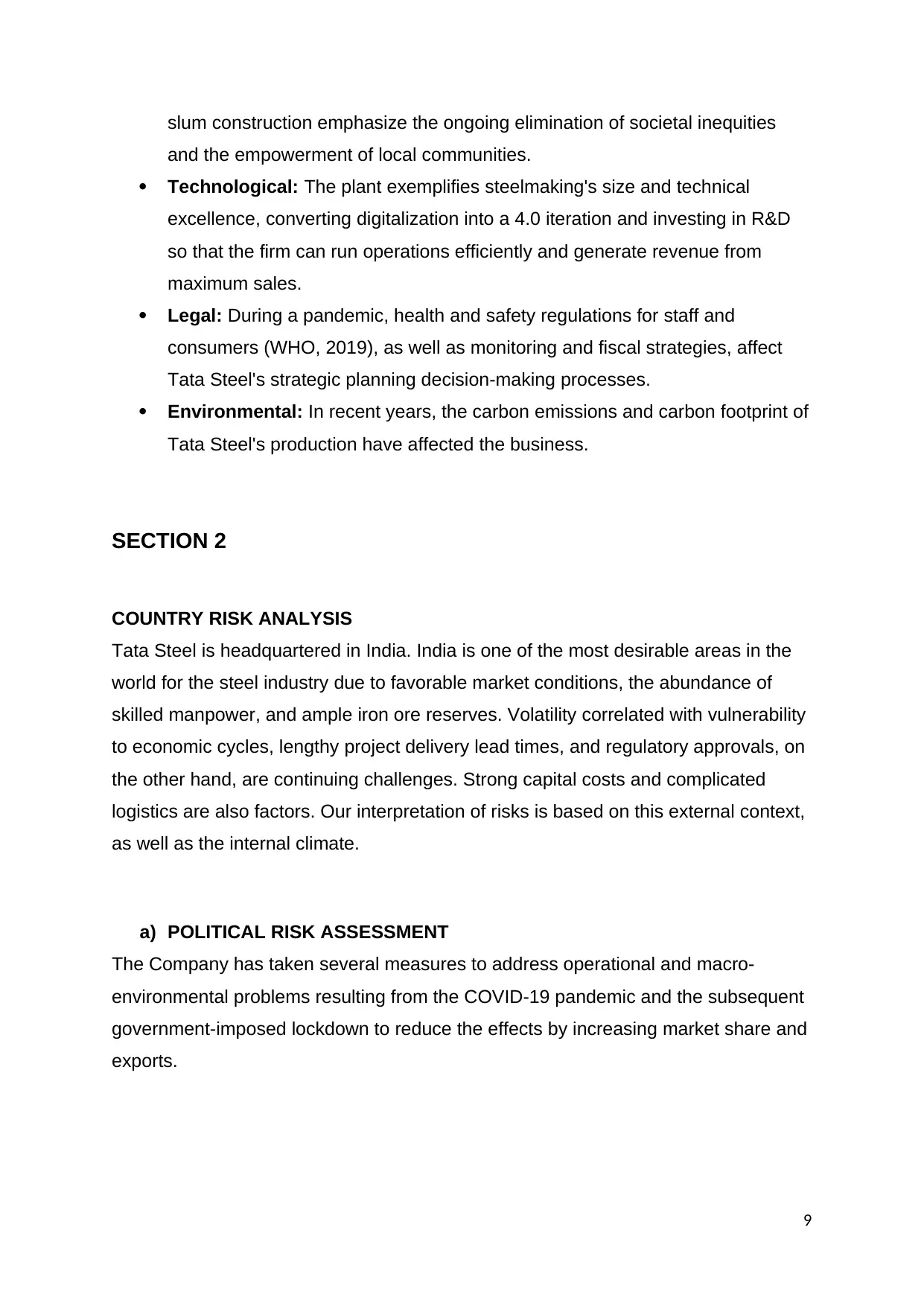
slum construction emphasize the ongoing elimination of societal inequities
and the empowerment of local communities.
Technological: The plant exemplifies steelmaking's size and technical
excellence, converting digitalization into a 4.0 iteration and investing in R&D
so that the firm can run operations efficiently and generate revenue from
maximum sales.
Legal: During a pandemic, health and safety regulations for staff and
consumers (WHO, 2019), as well as monitoring and fiscal strategies, affect
Tata Steel's strategic planning decision-making processes.
Environmental: In recent years, the carbon emissions and carbon footprint of
Tata Steel's production have affected the business.
SECTION 2
COUNTRY RISK ANALYSIS
Tata Steel is headquartered in India. India is one of the most desirable areas in the
world for the steel industry due to favorable market conditions, the abundance of
skilled manpower, and ample iron ore reserves. Volatility correlated with vulnerability
to economic cycles, lengthy project delivery lead times, and regulatory approvals, on
the other hand, are continuing challenges. Strong capital costs and complicated
logistics are also factors. Our interpretation of risks is based on this external context,
as well as the internal climate.
a) POLITICAL RISK ASSESSMENT
The Company has taken several measures to address operational and macro-
environmental problems resulting from the COVID-19 pandemic and the subsequent
government-imposed lockdown to reduce the effects by increasing market share and
exports.
9
and the empowerment of local communities.
Technological: The plant exemplifies steelmaking's size and technical
excellence, converting digitalization into a 4.0 iteration and investing in R&D
so that the firm can run operations efficiently and generate revenue from
maximum sales.
Legal: During a pandemic, health and safety regulations for staff and
consumers (WHO, 2019), as well as monitoring and fiscal strategies, affect
Tata Steel's strategic planning decision-making processes.
Environmental: In recent years, the carbon emissions and carbon footprint of
Tata Steel's production have affected the business.
SECTION 2
COUNTRY RISK ANALYSIS
Tata Steel is headquartered in India. India is one of the most desirable areas in the
world for the steel industry due to favorable market conditions, the abundance of
skilled manpower, and ample iron ore reserves. Volatility correlated with vulnerability
to economic cycles, lengthy project delivery lead times, and regulatory approvals, on
the other hand, are continuing challenges. Strong capital costs and complicated
logistics are also factors. Our interpretation of risks is based on this external context,
as well as the internal climate.
a) POLITICAL RISK ASSESSMENT
The Company has taken several measures to address operational and macro-
environmental problems resulting from the COVID-19 pandemic and the subsequent
government-imposed lockdown to reduce the effects by increasing market share and
exports.
9
⊘ This is a preview!⊘
Do you want full access?
Subscribe today to unlock all pages.

Trusted by 1+ million students worldwide
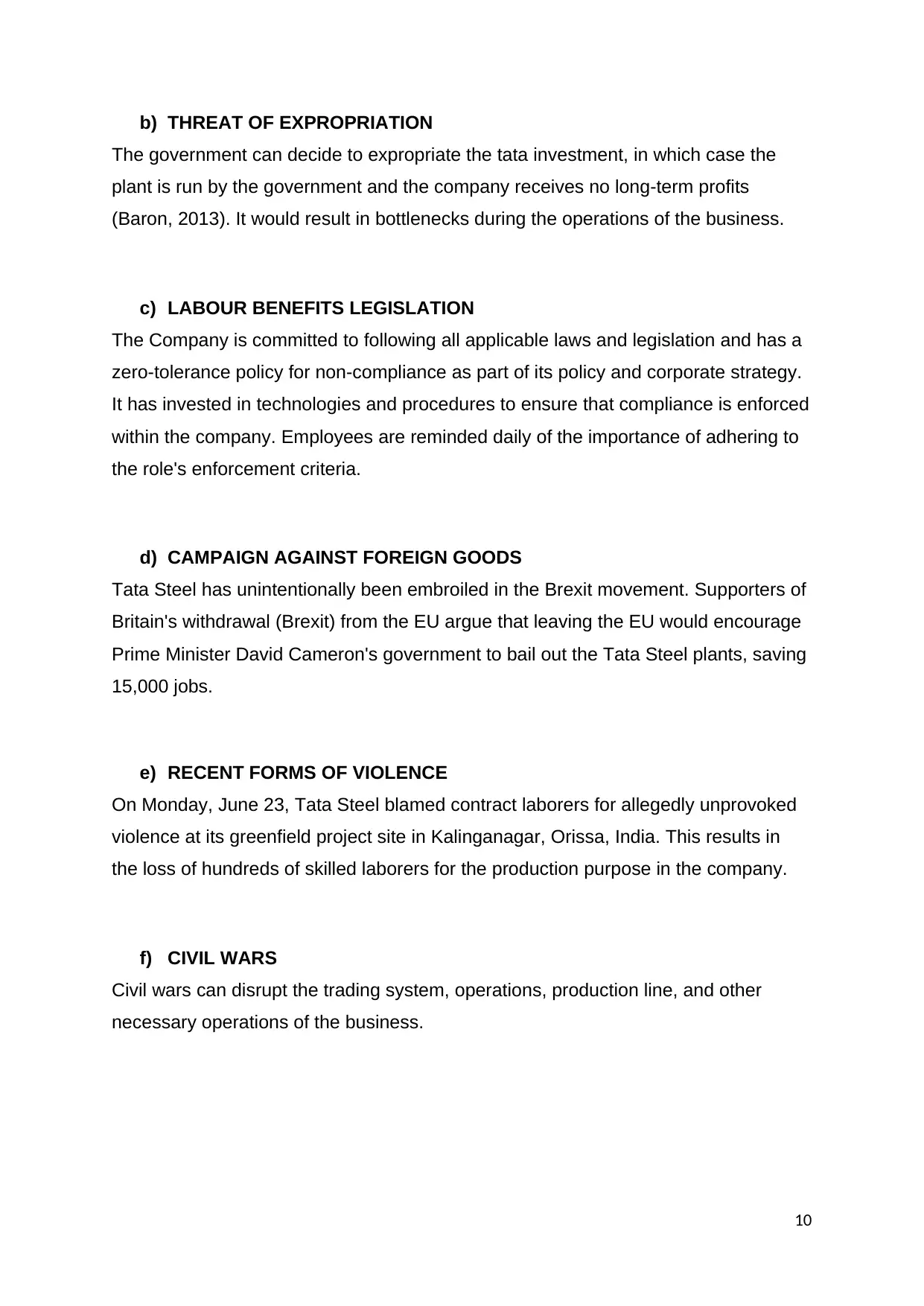
b) THREAT OF EXPROPRIATION
The government can decide to expropriate the tata investment, in which case the
plant is run by the government and the company receives no long-term profits
(Baron, 2013). It would result in bottlenecks during the operations of the business.
c) LABOUR BENEFITS LEGISLATION
The Company is committed to following all applicable laws and legislation and has a
zero-tolerance policy for non-compliance as part of its policy and corporate strategy.
It has invested in technologies and procedures to ensure that compliance is enforced
within the company. Employees are reminded daily of the importance of adhering to
the role's enforcement criteria.
d) CAMPAIGN AGAINST FOREIGN GOODS
Tata Steel has unintentionally been embroiled in the Brexit movement. Supporters of
Britain's withdrawal (Brexit) from the EU argue that leaving the EU would encourage
Prime Minister David Cameron's government to bail out the Tata Steel plants, saving
15,000 jobs.
e) RECENT FORMS OF VIOLENCE
On Monday, June 23, Tata Steel blamed contract laborers for allegedly unprovoked
violence at its greenfield project site in Kalinganagar, Orissa, India. This results in
the loss of hundreds of skilled laborers for the production purpose in the company.
f) CIVIL WARS
Civil wars can disrupt the trading system, operations, production line, and other
necessary operations of the business.
10
The government can decide to expropriate the tata investment, in which case the
plant is run by the government and the company receives no long-term profits
(Baron, 2013). It would result in bottlenecks during the operations of the business.
c) LABOUR BENEFITS LEGISLATION
The Company is committed to following all applicable laws and legislation and has a
zero-tolerance policy for non-compliance as part of its policy and corporate strategy.
It has invested in technologies and procedures to ensure that compliance is enforced
within the company. Employees are reminded daily of the importance of adhering to
the role's enforcement criteria.
d) CAMPAIGN AGAINST FOREIGN GOODS
Tata Steel has unintentionally been embroiled in the Brexit movement. Supporters of
Britain's withdrawal (Brexit) from the EU argue that leaving the EU would encourage
Prime Minister David Cameron's government to bail out the Tata Steel plants, saving
15,000 jobs.
e) RECENT FORMS OF VIOLENCE
On Monday, June 23, Tata Steel blamed contract laborers for allegedly unprovoked
violence at its greenfield project site in Kalinganagar, Orissa, India. This results in
the loss of hundreds of skilled laborers for the production purpose in the company.
f) CIVIL WARS
Civil wars can disrupt the trading system, operations, production line, and other
necessary operations of the business.
10
Paraphrase This Document
Need a fresh take? Get an instant paraphrase of this document with our AI Paraphraser
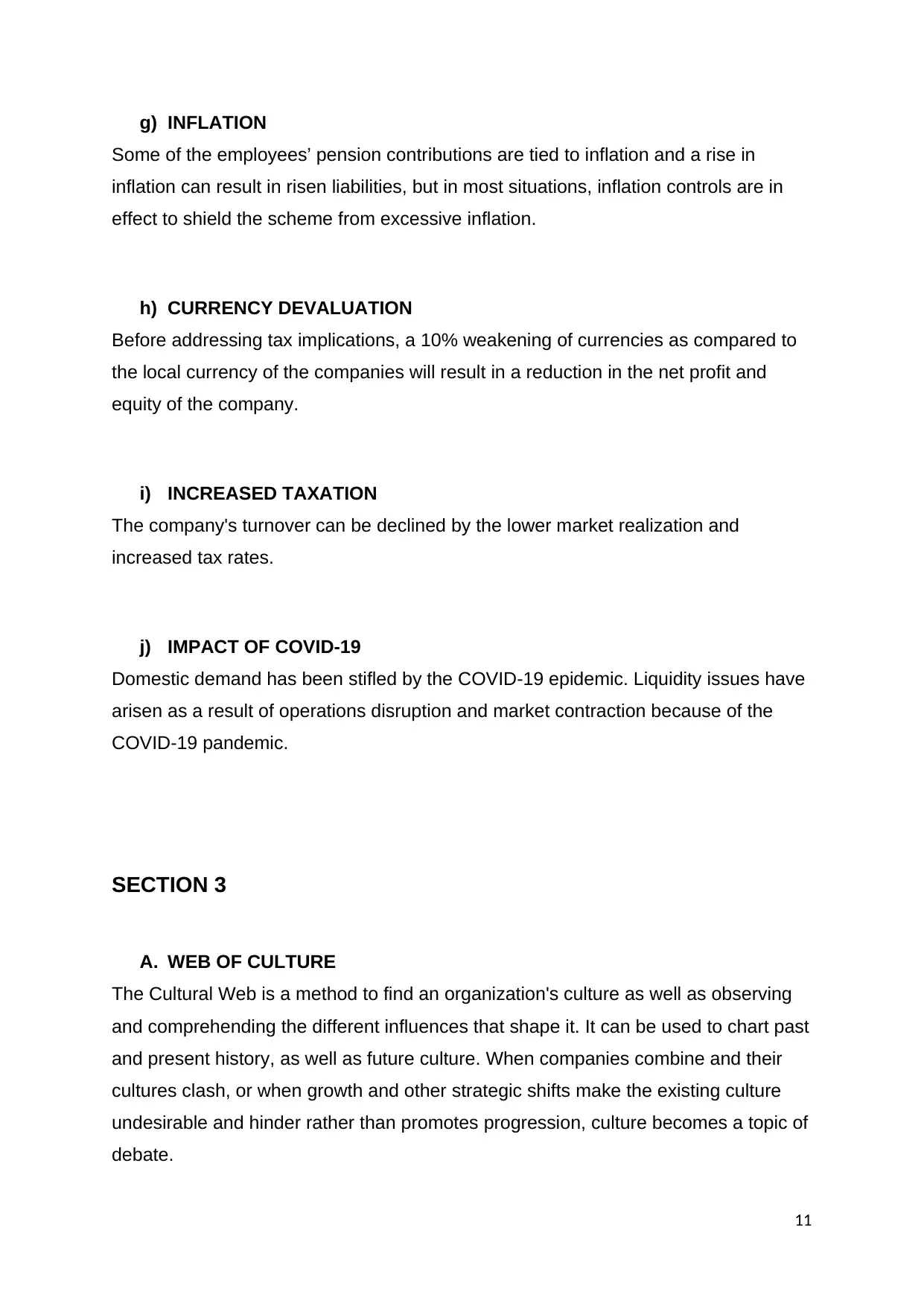
g) INFLATION
Some of the employees’ pension contributions are tied to inflation and a rise in
inflation can result in risen liabilities, but in most situations, inflation controls are in
effect to shield the scheme from excessive inflation.
h) CURRENCY DEVALUATION
Before addressing tax implications, a 10% weakening of currencies as compared to
the local currency of the companies will result in a reduction in the net profit and
equity of the company.
i) INCREASED TAXATION
The company's turnover can be declined by the lower market realization and
increased tax rates.
j) IMPACT OF COVID-19
Domestic demand has been stifled by the COVID-19 epidemic. Liquidity issues have
arisen as a result of operations disruption and market contraction because of the
COVID-19 pandemic.
SECTION 3
A. WEB OF CULTURE
The Cultural Web is a method to find an organization's culture as well as observing
and comprehending the different influences that shape it. It can be used to chart past
and present history, as well as future culture. When companies combine and their
cultures clash, or when growth and other strategic shifts make the existing culture
undesirable and hinder rather than promotes progression, culture becomes a topic of
debate.
11
Some of the employees’ pension contributions are tied to inflation and a rise in
inflation can result in risen liabilities, but in most situations, inflation controls are in
effect to shield the scheme from excessive inflation.
h) CURRENCY DEVALUATION
Before addressing tax implications, a 10% weakening of currencies as compared to
the local currency of the companies will result in a reduction in the net profit and
equity of the company.
i) INCREASED TAXATION
The company's turnover can be declined by the lower market realization and
increased tax rates.
j) IMPACT OF COVID-19
Domestic demand has been stifled by the COVID-19 epidemic. Liquidity issues have
arisen as a result of operations disruption and market contraction because of the
COVID-19 pandemic.
SECTION 3
A. WEB OF CULTURE
The Cultural Web is a method to find an organization's culture as well as observing
and comprehending the different influences that shape it. It can be used to chart past
and present history, as well as future culture. When companies combine and their
cultures clash, or when growth and other strategic shifts make the existing culture
undesirable and hinder rather than promotes progression, culture becomes a topic of
debate.
11
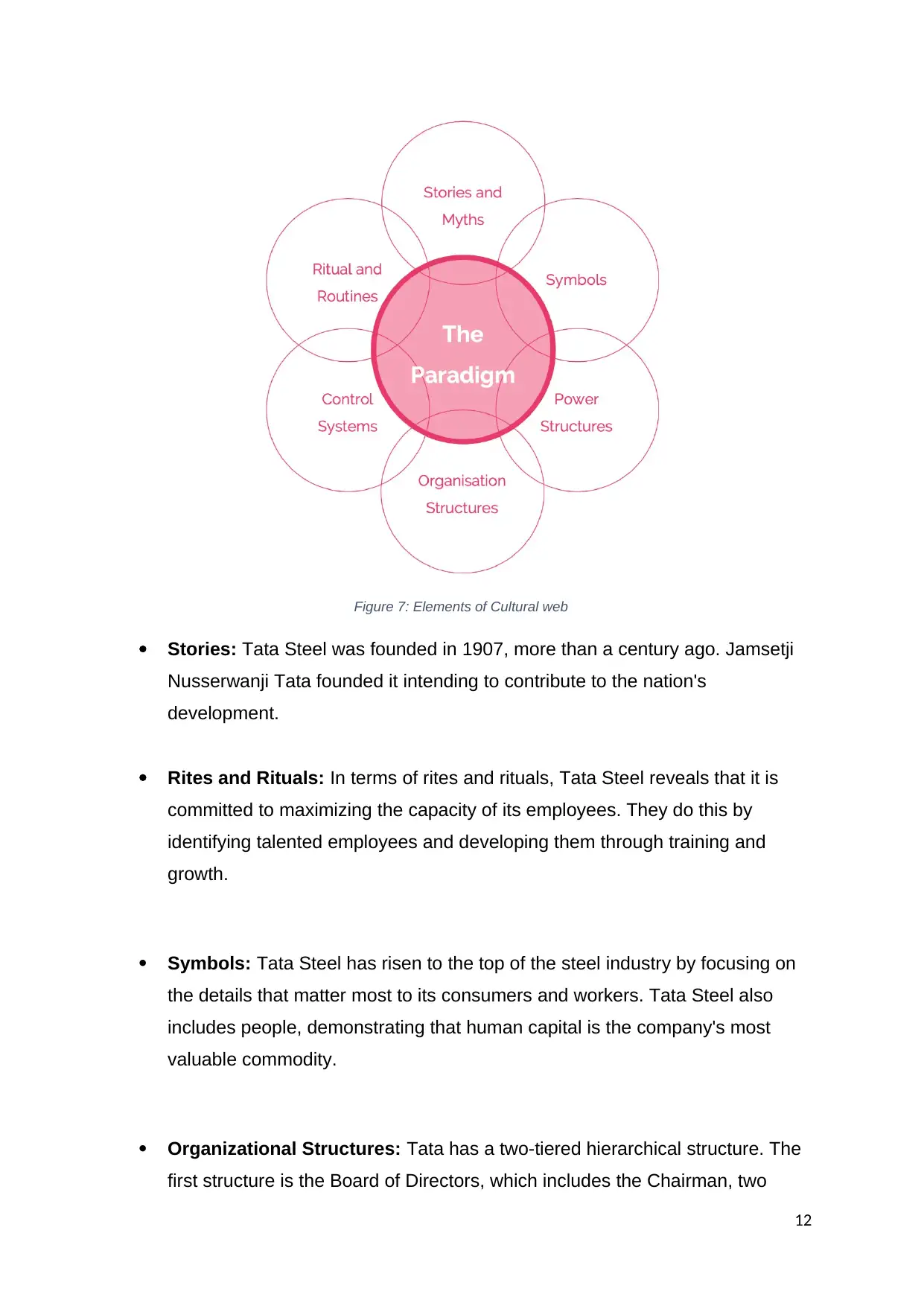
Figure 7: Elements of Cultural web
Stories: Tata Steel was founded in 1907, more than a century ago. Jamsetji
Nusserwanji Tata founded it intending to contribute to the nation's
development.
Rites and Rituals: In terms of rites and rituals, Tata Steel reveals that it is
committed to maximizing the capacity of its employees. They do this by
identifying talented employees and developing them through training and
growth.
Symbols: Tata Steel has risen to the top of the steel industry by focusing on
the details that matter most to its consumers and workers. Tata Steel also
includes people, demonstrating that human capital is the company's most
valuable commodity.
Organizational Structures: Tata has a two-tiered hierarchical structure. The
first structure is the Board of Directors, which includes the Chairman, two
12
Stories: Tata Steel was founded in 1907, more than a century ago. Jamsetji
Nusserwanji Tata founded it intending to contribute to the nation's
development.
Rites and Rituals: In terms of rites and rituals, Tata Steel reveals that it is
committed to maximizing the capacity of its employees. They do this by
identifying talented employees and developing them through training and
growth.
Symbols: Tata Steel has risen to the top of the steel industry by focusing on
the details that matter most to its consumers and workers. Tata Steel also
includes people, demonstrating that human capital is the company's most
valuable commodity.
Organizational Structures: Tata has a two-tiered hierarchical structure. The
first structure is the Board of Directors, which includes the Chairman, two
12
⊘ This is a preview!⊘
Do you want full access?
Subscribe today to unlock all pages.

Trusted by 1+ million students worldwide
1 out of 17
Related Documents
Your All-in-One AI-Powered Toolkit for Academic Success.
+13062052269
info@desklib.com
Available 24*7 on WhatsApp / Email
![[object Object]](/_next/static/media/star-bottom.7253800d.svg)
Unlock your academic potential
Copyright © 2020–2025 A2Z Services. All Rights Reserved. Developed and managed by ZUCOL.




